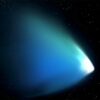The gold that makes up your most precious jewelry may have been forged in a violent cosmic collision millions or billions of light years away between two neutron stars. New research seeks to better understand this process.
There is only a single confirmed site in the universe capable of generating conditions extreme enough to initiate the production process for many of the heaviest elements in the universe, including gold, platinum, uranium—neutron star mergers. These mergers are the only event observed to-date that can produce the incredible densities and temperatures needed to power the rapid neutron capture process.
In a new paper in The European Physical Journal D, Andrey Bondarev, a postdoc researcher at Helmholtz Institute Jena, James Gillanders a postdoc researcher in Rome, and their colleagues examine the spectra from the kilonova AT2017gfo to investigate the presence of forged tin, by looking for spectral features caused by its forbidden transitions.
“We have demonstrated that accurate atomic data, especially for forbidden magnetic dipole and electric quadrupole transitions, which are unknown for many elements, are important for kilonova analysis,” Bondarev says. “By calculating a large number of energy levels and rates of multipole transitions between them in singly ionized tin, using the method that combines linearized coupled-cluster and configuration interaction approaches, we generated an atomic data set that can be used for future astrophysical analysis.”
The team’s research shows that a magnetic dipole transition between the levels of the ground-state doublet of singly ionized tin leads to a prominent and observable feature in kilonova emission spectra.
“Although this does not match any prominent features in the AT2017gfo spectra, it can nevertheless be used as a probe for future kilonova events,” Gillanders explains. “The more elements that can be positively identified, the closer we get to understanding these incredible cosmic explosions.”
The team point out that kilonova events are only a recently observed phenomenon, with the first spectroscopic observations only obtained in 2017. Better atomic data such as that provided in this study will be essential in better understanding the explosive collisions associated with neutron star mergers.
“We hope our work can contribute in some way to the advancement of our understanding of the process that produces the heaviest elements in the universe,” Gillanders concludes. “We are eager for the discovery of new kilonovae and associated new sets of observations, which will allow us to develop our understanding of these events.”
More information:
A. I. Bondarev et al, Calculations of multipole transitions in Sn II for kilonova analysis, The European Physical Journal D (2023). DOI: 10.1140/epjd/s10053-023-00695-5
Citation:
Looking deeper into violent neutron star collisions to find the origins of heavy elements (2023, July 21)



